Key Defenses
- There are five types of camouflage in the wild, color matching, disruptive coloration, active camouflage, mimicry, and self-decoration.
- Some animals have a unique mark or pattern on their skin, fur, or scales to inform predators of how dangerous the animal is before engaging.
- The shells of turtles and insects are part of their body, providing them with armor from predators.

Turtles and tortoises have the advantage of having protective armor covering them at all times to deter predator attacks.
©Ingrid Curry/Shutterstock.com
Surviving in the wild is a treacherous endeavor. There are large predators around every corner, insects capable of transmitting lethal diseases within months, and conflicts with rival animals to forage for a decreasing surplus of food. To survive predators who are larger, stronger, and faster, animals must adapt unique defense mechanisms to even the fight.
A defense mechanism is a natural reaction to something else, typically seen as dangerous. This article will highlight some of the most popular defense mechanisms in the animal kingdom, and how they can repel the biggest predators in the ecosystem.
Unique Weapons
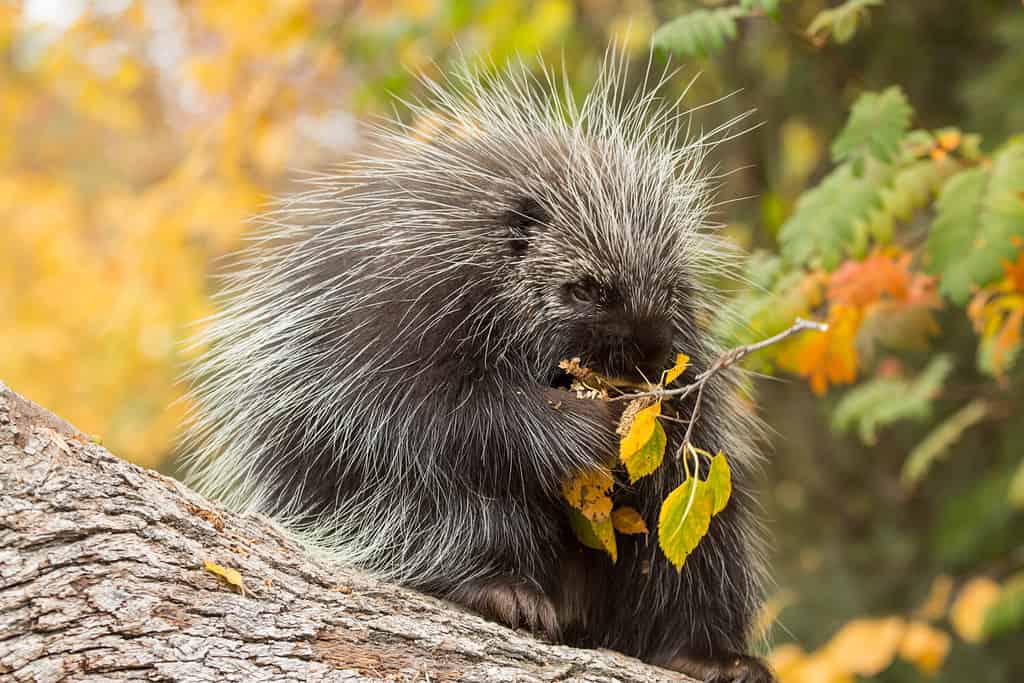
Porcupine
quills have tiny hooks at the end to stick into predators longer and make it more difficult and painful to remove.
©Warren Metcalf/Shutterstock.com
Animals evolve their bodies to wield unique weapons to combat larger threats. Some of the most recognizable weaponry for animals are spikes, quills, and bone protrusions. For thousands of years, animals have adapted weapons to fight carnivores to protect themselves or their young. Triceratopses are some of the most popular dinosaurs, easily recognized by their triple horn skull which helped them combat Allosaurus and Tyrannosaurus Rex.
Most predators want an easy kill by ambushing their prey or aiming directly for the neck, severing the spine for an instant kill. If a predator has to fight their meal, there is a chance they could get hurt which will make them less efficient for the next hunt. Also, a wounded predator is prey for a healthier predator. When faced with an animal with weaponry, predators hesitate before attacking.
For example, porcupines have nearly 30,000 quills lining their body. When flat, they are mostly harmless. When upright, they hook into a predator’s skin causing sharp pain as they pierce the nerves. A predator fighting porcupine risks getting quilled in the face, damaging their eyes, nose, ears, and mouth.
Examples of animals using unique weapons include:
- Sharp quills/spikes: porcupines, hedgehogs, stegosaurus, sea urchins, echidna, stingray
- Tusks and horns: elephants, walrus, rhinos, triceratops
- Antlers: deer, elk, moose
- Bones: Iberian ribbed newts use ribs as spikes
- Strong heads: giraffes use heads like wrecking balls.
- Clubs: ankylosaurus
- Electrocution: electric eels
Armor
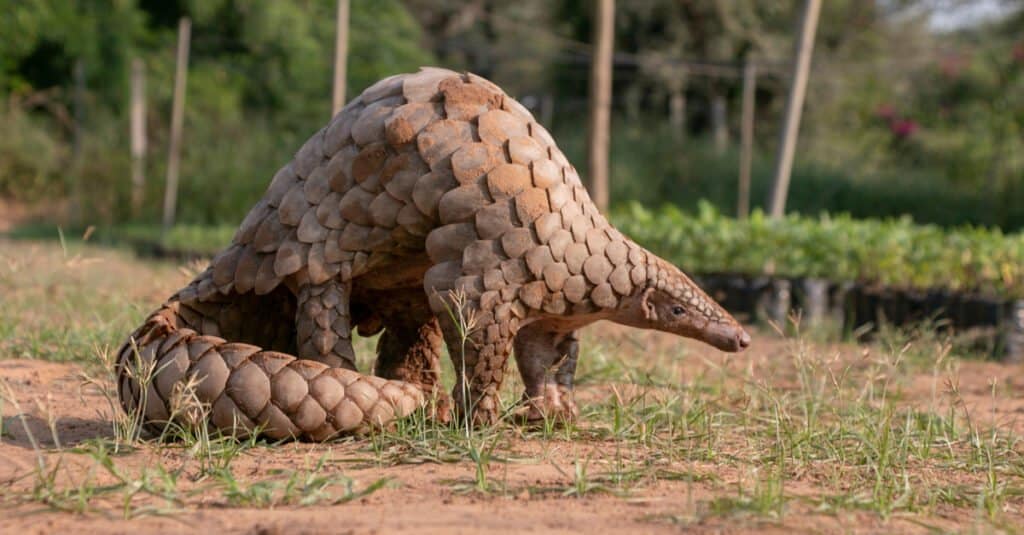
Pangolins curl into medium-sized balls which make it difficult for predators to bite their exposed underside.
©Vickey Chauhan/Shutterstock.com
When weapons do not work, having a protective suit of armor is the next best option. Common animals like turtles and tortoises are known for having hard shells to protect them from predators. Their shells prevent medium-sized predators from breaking through, forcing them to give up.
Predators are constantly on the hunt for food to fuel their bodies. They do not have time or the energy to find ways of breaking into a hard shell when other prey is easier to catch and kill.
Alternatively, some animals will use spikes to form a defensive barrier, forcing the predator to think if biting through the spikes or quills is worth the damage to get the precious meat.
Armor can be made from a variety of materials. Some animals have hard scales of keratin protecting them from danger, others have exoskeletons that molt as they grow, and some adopt shells for protection and use those until a bigger one is more suitable. Small prey will roll into a ball, covering their soft underbelly in a dense shield, deterring predators.
Examples of animals possessing hard shells include:
- Shells: turtles, tortoises, armadillos
- Scales: pangolins, ankylosaurus
- Exoskeletons: insects, arthropods, crustaceans
- Clams, oysters, mussels
- Adoptive shells: snails, hermit crabs,
- Spikes: hedgehogs
Camouflage

Chameleons can alternate their skin cells to change color and shape to mimic the environment around them to avoid predators and catch insects.
©Brenton Schappell/Shutterstock.com
Camouflage is the strategy where animals disguise their appearance by blending into their environment. This does not mean the animals are invisible, they are an optical illusion to fool prey into thinking there is nothing in the area. Animals must remain very still to create the illusion as a deep breath or body twitch can break the illusion, leaving them vulnerable to predation.
In the wild, there are five different types of camouflage animals can use.
- Color matching: An animal’s coat or fur will naturally blend into the environment, making them difficult to see.
- Disruptive coloration: An animal’s coat uses multiple colors, spots, stripes, and patterns to distort their body line, making them blend into the environment. Interestingly, predators like tigers and jaguars use their stripes and spots to help them ambush prey.
- Self-decoration: Animals will cover themselves in their surroundings to help them hide better.
- Active camouflage: Certain animals with active camo can actively change the color and pattern of their skin to match their surroundings.
- Mimicry: Animals will mimic their surroundings by pretending to be something less appetizing to a predator like a stick or a leaf.
Examples of animals using camouflage include:
- Color matching: deer, foxes, frogs, butterflies, grasshoppers, kangaroos, wallabies
- Disruptive coloration: owls, zebras, ostriches, rockfish, iguanas, turtle shells
- Self-coloration: urchins, turtles, crabs and algae, sloths
- Active camo: chameleons, arctic hares, flounder
- Mimicry: Stick bugs, leaf insects, butterflies, moths, caterpillars
Playing Dead
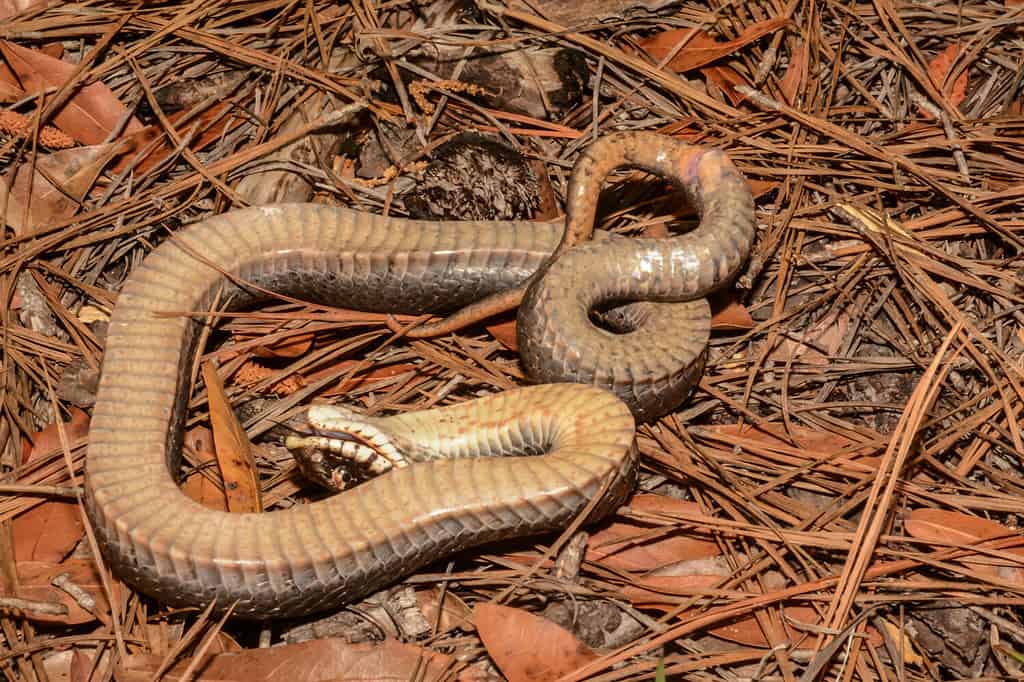
The hognose snake rolls over and can limit its breathing for an extensive period of time to fool predators.
©Jay Ondreicka/Shutterstock.com
Predators like to eat fresh meat, so they get the most nutrients out of their prey. Unless food is scarce or they are scavengers, most predators will avoid eating dead meat because of hazardous bacteria from rotting flesh.
Animals recognize predator’s aversion to dead meat and replicate this by playing dead. The practice is commonly called “playing possum” because possums and opossums are experts in this technique. They will make their eyes go blank, slow their breathing, secrete a stench skin to rotting flesh, and defecate themselves to sell the illusion they are undesirable. When the predator moves on, the animals will magically come back to life and continue on their journey.
Examples of animals playing dead include:
- Opossums
- Web spiders
- Hog-nosed snakes
- Grasshoppers
- Ducks
- Japanese quails
Regeneration

Octopus and squid tentacles will disconnect and latch onto the predator, making it think they are still fighting the whole cephalopod.
©Olga Visavi/Shutterstock.com
Regeneration is the process where new tissue replaces lost or damaged tissue. All animals have a process of regenerating old cells as they age, but some animals have a higher regeneration rate than others.
Animals using regeneration as a defense mechanism can regrow limbs or sections of their entire body to escape predators. The most common animals using regeneration are lizards. Many lizards are capable of detaching their tails to escape a predator and regrow it later. However, lizards cannot regrow limbs or pieces that have dense bones.
Alternatively, sea life like sea stars and octopuses have extreme regenerative capabilities where the lost limb will continue moving on its own to trick predators into believing they are still fighting the main body. Several sea sponges can lose sections of their body, attach to other pieces of coral, and grow entirely new bodies.
Animals that lose a limb do not suffer long as the missing appendage grows back within a few weeks.
Examples of animals using regeneration include:
- Lizard
- Cephalopods: octopus, squid, cuttlefish
- Starfish
- Salamanders and axolotls
- Crustaceans
Chemical Repellents
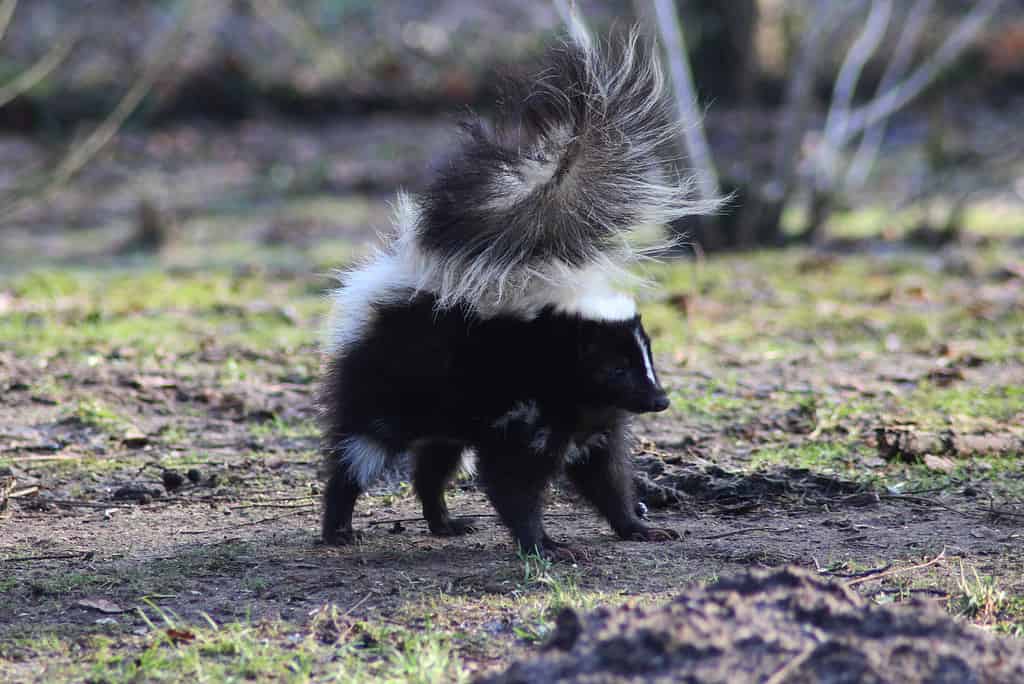
Wild animals recognize skunks and will avoid them the moment their tail goes up. Domestic pets take longer or rarely learn to avoid skunks.
©michael meijer/iStock via Getty Images
The use of chemical warfare is banned in human combat because it is deemed too cruel. However, animals have no qualms about weaponizing toxins to hunt or escape. These chemicals range from mild irritation, disorientation, and disgust, to lethal.
Certain animals like skunks develop marks on their body to warn predators to leave them alone or else they will suffer the consequences of a pungent smell that will make their hunts more difficult. A skunked predator cannot hide their scent and will have trouble sneaking up on prey because the skunk smell will constantly block their noses.
Snakes and jellyfish have varying levels of toxic venom which can either stink, paralyze, or kill a full-grown human within minutes. Certain frogs secrete a poison on their skin which can cause severe irritation to predators when they try biting them.
To clarify, toxins are substances that are poisonous to others. There are two types of toxins:
- Poison: a toxin that gets into the body by inhalation, ingestion, or skin contact. (IE: you bite it and you become sick)
- Venom: a toxin that is injected into the body. (IE: it bites you and you become sick)
Alternatively, animals can secrete fluids off their body to cause irritation, allowing the prey to get away.
Examples of animals using chemical defenses include:
- Venom: pythons, cobras, blue-ring octopus, stonefish, spiders, scorpions, jellyfish
- Poison: newts, toads, frogs, flowers
- Slime: hagfish
- Body Fluids: Texas-horned lizard (blood), pygmy sperm whales (poop)
- Skunks
Greater Numbers
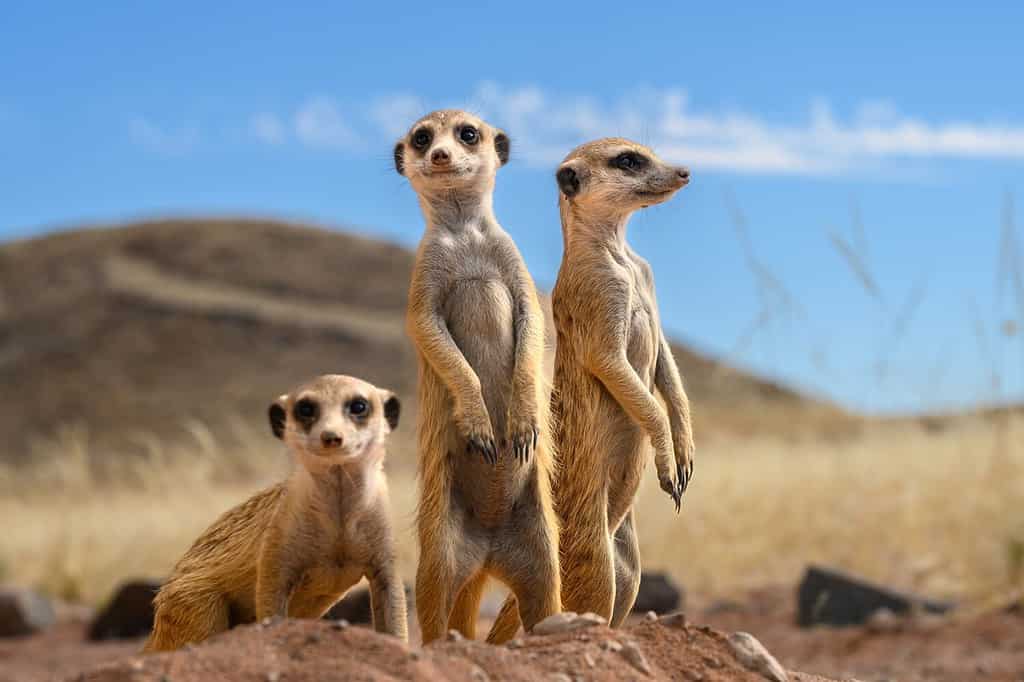
Meerkats work in shifts as lookouts, foragers, and times to rest.
©Ward Poppe/Shutterstock.com
When animals do not have unique weapons or alternative methods of defending themselves alone, they will work together in large numbers to keep each other safe. They will form large communities that protect the herd.
For example, prairie dog colonies can stretch for miles, having hundreds of residents in their collective networks. Several prairie dogs will search for food, build tunnels, and groom their young while others will stand as a lookout for predators. When one is spotted, they will release a loud cry to warn their neighbors of danger, providing them ample time to return to a safe location.
Scientists notice groups of animals like prairie dogs or vervet monkeys release different calls to identify specific predators.
Big animals like elephants will work together to create a massive shield to protect their young from predators. They will line their bodies in a circle around their youth, creating a nearly impenetrable wall of feet, tusks, and tusks to prevent predators from getting past.
Examples of animals working in large groups include:
- Insects: ants, termites
- Prairie dogs
- Monkeys
- African elephants
- Triceratops
- Whales
Deception

Milksnakes are small constrictors, catching prey and squeezing them tight before eating.
©slowmotiongli/Shutterstock.com
This defense mechanism is remarkably similar to mimicry camouflage, but the animals are not trying to hide. Instead, animals will make themselves look like other animals which are more dangerous.
For example, milk snakes are non-venomous snakes that are relatively harmless on their own. But they adopted the colors of the coral snake, a highly venomous snake that many predators avoid. By adopting the colors of the more venomous coral snake, the milk snake can trick predators into thinking it is a coral snake.
Alternatively, the African fork-tailed drongo are scavengers that mimic the predator calls of meerkats. The meerkats are fooled into believing a predator is coming, abandoning their spoils for the drongo to consume.
Butterflies and moths will have unique patterns on the tips of their wings to mimic the appearance of the predator’s eyes. A small predator seeing a larger predator’s eyes will hesitate and flee, hoping to escape the bigger threat.
Teeth and Claws
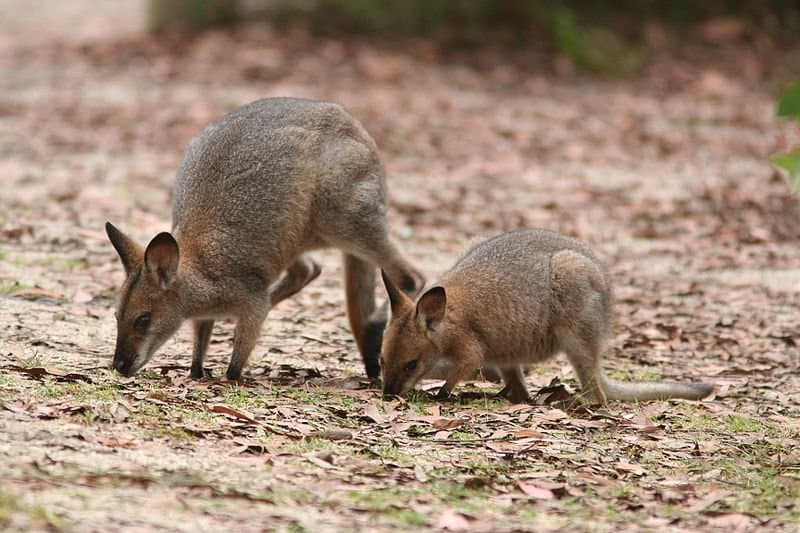
Wallabies are tiny kangaroos with powerful back legs which they use to outrun prey. In case of a battle, they can kick with enough force to into the soft underside of animals.
When all else fails, animals will use their claws and teeth to fight back. They may not be as strong or sharp as predator claws and teeth, but something is better than nothing when fighting for your life. A lucky scratch in the eye or a deep cut on the nose can offer a brief moment for the predator to hesitate, providing a chance to escape.
The hairy frog will break their finger bones to create makeshift claws to combat rivals or predators if the need arises. Iberian ribbed newts can use their ribs as spikes while releasing a poisonous substance to evade prey.
Kangaroos and wallabies have powerful back legs and can tear into flesh and break bones with a couple of kicks to the chest. Ostriches have equally strong legs to stomp on predators and flee at great speed.
Rabbits and rodents have strong teeth capable of chewing metal that can wound a predator for a moment to use their speed to get away.
Summary of Self-Defense Mechanisms
| Defense Mechanism | Examples |
|---|---|
| Weaponry | Spikes, quills, electricity, clubs, horns, tusks, size |
| Armor | Shells, scales, spikes, exoskeletons |
| Camouflage | Hiding in plain sight |
| Chemical weapons | Gas, blood, poop, venom, poison, slime |
| Deception | Looking like someone more dangerous |
| Teeth and claws | Slashing, biting, and fighting to get away |
The photo featured at the top of this post is © Noorhussain/iStock via Getty Images
Thank you for reading! Have some feedback for us? Contact the AZ Animals editorial team.






